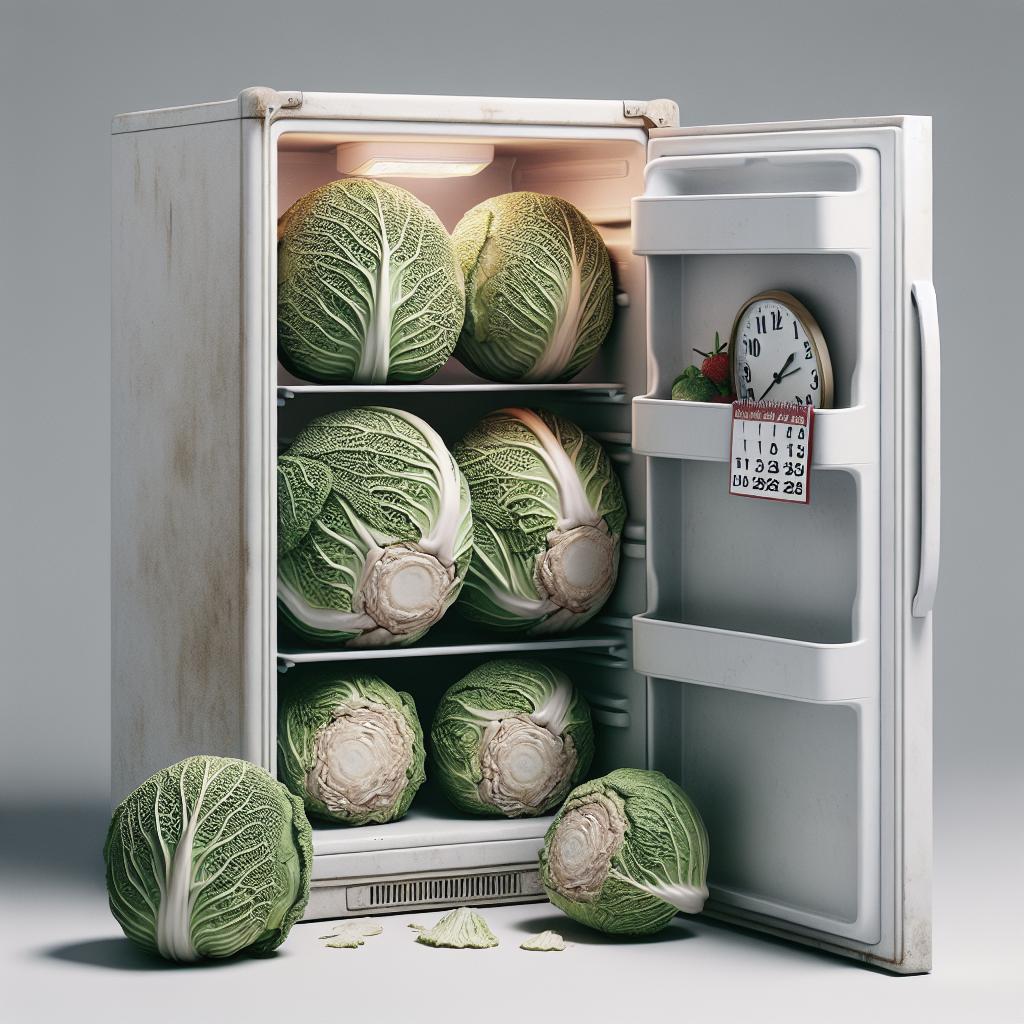Cabbage is a versatile vegetable that can add flavor, crunch, and nutrition to various dishes. Whether you’re using it for salads, stir-fries, or traditional dishes like sauerkraut, knowing how to store cabbage properly is vital to ensuring its freshness and saving money. In this blog post, we’ll guide you through choosing the best cabbage, storing a whole head or partial head, freezing, fermenting, and recognizing spoilage signs. By the end, you’ll be well-equipped to keep your cabbage fresh and delicious for as long as possible.
How to Choose Cabbage
Choosing the right cabbage is the first step in ensuring it stays fresh for as long as possible. When you’re at the grocery store or farmer’s market, look for cabbages that feel firm and heavy for their size. The leaves should be tightly packed, free from blemishes or yellowing. Avoid cabbages with spots, cracks, or loose leaves, as these can signal aging or damage that will reduce shelf life. Different types of cabbage—green, red, Savoy, and Napa—will have different textures and flavors. Green and red cabbages tend to have thicker, more resilient leaves, making them longer-lasting options. Savoy and Napa have more delicate leaves but can still offer considerable shelf-life if chosen carefully. Once you’ve selected your cabbage, you’re set up for success in terms of storage. Proper handling and storage techniques at home will ensure your cabbage remains fresh and ready to use for as long as possible.
How to Store a Head of Cabbage
Storing a whole head of cabbage is relatively straightforward. Start by removing any loose outer leaves. These leaves are often damaged or dirty and can accelerate spoilage if left attached. Do not wash the cabbage before storing it, as moisture can lead to mold and rot. Place the head of cabbage in a plastic bag, such as a perforated produce bag, to maintain its crispness. If you don’t have a produce bag, a loosely wrapped plastic or paper bag will also work. Store the cabbage in the crisper drawer of your refrigerator, where the temperature and humidity levels are optimal for keeping it fresh. When stored correctly, a whole head of cabbage can last up to two months in the fridge. Regularly check the leaves for any signs of aging, such as wilting or discoloration, to catch and remove problematic areas before they affect the rest of the head.
How to Store a Partial Head of Cabbage
If you’ve cut into your cabbage but haven’t used the entire head, you’ll need a slightly different approach for storage. Begin by wrapping the cut side of the cabbage in plastic wrap or aluminum foil to create a tight seal. This barrier helps prevent the cabbage from drying out and keeps it fresh for use later. Place the wrapped cabbage in a plastic bag before storing it in the refrigerator. Like a whole head, keeping the partial head in the crisper drawer is your best bet for maintaining optimal freshness. Stored this way, a partially used head of cabbage can remain fresh for about one to two weeks. It’s essential to inspect your partial head of cabbage regularly. If you notice any drying or browning on the cut surface, simply trim off the affected area before using the rest. By managing and monitoring your partial cabbage, you can extend its usability and minimize food waste.
How to Freeze and Ferment Cabbage
How to Freeze Cabbage
Freezing cabbage is an excellent way to extend its shelf life, allowing you to enjoy it long after its typical storage period. Start by blanching the cabbage to lock in its color and flavor. To blanch, cut the cabbage into wedges or strips and boil for about two minutes. Immediately transfer the pieces to an ice bath to halt the cooking process. Once the cabbage is cooled, drain it thoroughly and pat it dry with paper towels. Spread the pieces out on a baking sheet in a single layer and freeze them until solid. Once frozen, transfer the cabbage to a resealable plastic bag or airtight container. Label the bag with the date, so you know how long it’s been stored. Frozen cabbage can last eight to ten months, making it a great option for long-term storage. Keep in mind that thawed cabbage may have a softer texture, making it more suitable for cooked dishes rather than raw preparations.
How to Ferment Cabbage
Fermenting cabbage to make sauerkraut or kimchi is not only a delicious way to enjoy this vegetable but also a method that significantly extends its shelf life. Start by shredding the cabbage and mixing it with salt (about one tablespoon per pound of cabbage). Let the cabbage sit for about an hour so the salt can draw out the moisture. Pack the salted cabbage tightly into a fermentation container, like a Mason jar or a crock. Ensure the cabbage is submerged in its liquid to avoid spoilage. Leave a bit of room at the top for expansion as fermentation gases are produced. Cover the container with a lid or a cloth secured with a rubber band, and store it at room temperature away from direct sunlight. Fermentation takes about five to ten days, depending on your room temperature and taste preference. Once fermented, transfer the cabbage to the fridge, where it can keep for several months.
How to Tell if Cabbage Is Spoiled
Even with the proper storage techniques, cabbage can eventually spoil. Being able to identify the signs of spoilage is crucial for both food safety and quality. The first indication is sight: look for signs like yellowing leaves, wilting, or shriveling. Discard cabbage with significant discoloration or mold presence immediately. Smell is another telltale sign of spoilage. Fresh cabbage has a relatively neutral odor. If your cabbage emits a foul, sour, or off-putting smell, it’s past its prime. Trust your nose and err on the side of caution when in doubt. Finally, texture can provide clues. Fresh cabbage should feel crisp and firm to the touch. If the cabbage feels slimy, overly soft, or mushy, it’s best to discard it. Regularly check your stored cabbage to catch any signs of spoilage early, helping you make the most out of this versatile vegetable.
Next steps
| Topic | Summary |
|---|---|
| How to Choose Cabbage | Pick firm, heavy heads with tightly packed, blemish-free leaves. |
| How to Store a Head of Cabbage | Store whole heads in a plastic bag in the fridge’s crisper drawer; lasts up to two months. |
| How to Store a Partial Head of Cabbage | Wrap the cut side in plastic wrap, store in a bag in the crisper drawer; lasts 1-2 weeks. |
| How to Freeze Cabbage | Blanch, freeze on a baking sheet, and store in resealable bags; lasts 8-10 months. |
| How to Ferment Cabbage | Shred, salt, pack into containers, and ferment at room temperature; lasts several months refrigerated. |
| How to Tell if Cabbage Is Spoiled | Check for yellowing, wilting, unpleasant odors, and slimy texture. |


